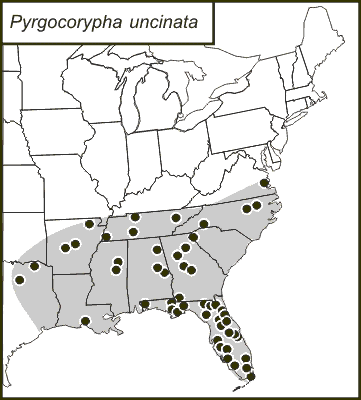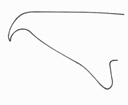| Song : | High-pitched ringing hiss modulated momentarily 4-5 times per second. |
| Song data: | Excel worksheet and chart (from spectrographic analyses). |
| Identification: | Wings extending beyond abdomen; cone ending in a sharp, down-turned point, prominent gap separating cone from face. Length 47-62 mm for Florida specimens; 44-54 mm northward. |
| Similar species: | Neoconocephalus triops is similar in that males call from undergrowth and treetops in the spring, but their songs are unbroken or broken at ca. 1 s intervals and their first singing is earlier in the spring. |
| Habitat: | Poorly known. Juveniles may feed and develop on grasses. Males sing from trees and from woodland undergrowth. |
| Season: | Adults mature in late summer or fall and do not become reproductively active until Mar.–May (peninsular Fla.) or Apr.–May (N. Car.). Singing occurs later on the Florida Keys (Apr.–July) than elsewhere, possibly as an adaptation that allows juveniles to avoid the spring dry season; n. Fla. data. |
| Remarks: | Brown females and green females occur in approximately equal numbers; males are always brown--a sex-influenced color dimorphism similar to that of overwintering adults of N. triops. This and N. triops are the only U.S. coneheads that occur both in the West Indies and in temperate North America. They are also the only ones that produce no overwintering eggs. |
| More information: |
Subfamily Copiphorinae. |
| Nomenclature: | OSF (Orthoptera Species File Online). |












